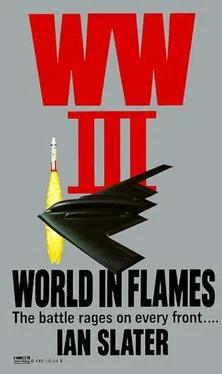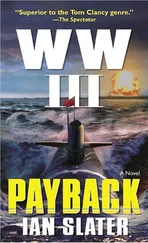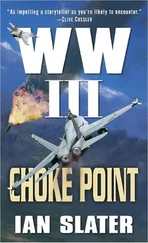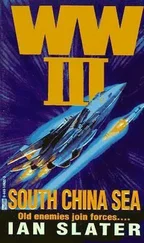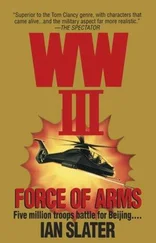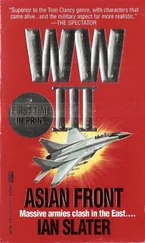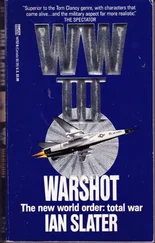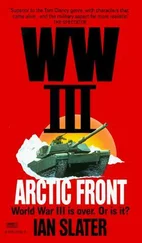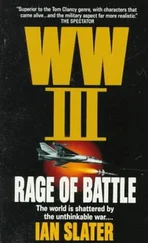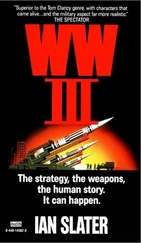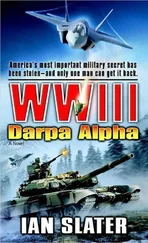Ian Slater - World in Flames
Здесь есть возможность читать онлайн «Ian Slater - World in Flames» весь текст электронной книги совершенно бесплатно (целиком полную версию без сокращений). В некоторых случаях можно слушать аудио, скачать через торрент в формате fb2 и присутствует краткое содержание. Год выпуска: 1991, ISBN: 1991, Издательство: Ballantine Books, Жанр: Триллер, на английском языке. Описание произведения, (предисловие) а так же отзывы посетителей доступны на портале библиотеки ЛибКат.
- Название:World in Flames
- Автор:
- Издательство:Ballantine Books
- Жанр:
- Год:1991
- ISBN:0-449-14564-6
- Рейтинг книги:5 / 5. Голосов: 1
-
Избранное:Добавить в избранное
- Отзывы:
-
Ваша оценка:
- 100
- 1
- 2
- 3
- 4
- 5
World in Flames: краткое содержание, описание и аннотация
Предлагаем к чтению аннотацию, описание, краткое содержание или предисловие (зависит от того, что написал сам автор книги «World in Flames»). Если вы не нашли необходимую информацию о книге — напишите в комментариях, мы постараемся отыскать её.
World in Flames — читать онлайн бесплатно полную книгу (весь текст) целиком
Ниже представлен текст книги, разбитый по страницам. Система сохранения места последней прочитанной страницы, позволяет с удобством читать онлайн бесплатно книгу «World in Flames», без необходимости каждый раз заново искать на чём Вы остановились. Поставьте закладку, и сможете в любой момент перейти на страницу, на которой закончили чтение.
Интервал:
Закладка:
Second on the ground was David Brentwood. He saw Cheek-Dawson swiftly and expertly folding his chute while he, David, released the parachute harness and ran over to the fallen man. The man had struck soft moorland, but his head had burst like a coconut, a hairy mash splattered on the turf, the man’s body strangely flat — an illusion created by the fact that hitting the ground at over one hundred miles per hour, his body had penetrated six inches into the turf, every bone broken.
“Brentwood!” bawled out Cheek-Dawson.
“Sir?”
“Go and fold your chute, man. See it for bloody miles!”
The only thing David could think of was that this was only their first HALO. There would be two more “daylights,” this same day, and then a night HALO, from twenty-five thousand feet. Full kit and oxygen masks.
CHAPTER FORTY-THREE
As the IX-44E sludge-removal vessel—”self-propelled”— putt-putted out of San Diego harbor, the carrier USS Salt Lake City towered above the tiny vessel like a skyscraper, and even the men on the hangar deck one story below the flight deck looked toy-sized to Brentwood, while the carrier’s anchor chain alone would have sunk his barge. One of the sailors high up on the hangar deck, holding a bucket, gazed down at the small slab of wood that was the barge’s deck and at the butter-box wheelhouse. Mockingly he saluted the tiny apparition. There was a roar of laughter from the carrier, made louder by its echoing off its enormous steel sides, as Ray Brentwood and his nine men — the other two of the crew of eleven in the engine room, or rather engine cubbyhole — returned the salute. Brentwood’s face was flushed — hot with embarrassment as more and more of the carrier’s sailors and yardbirds working on the great ship lined up stem to stern to watch the joke sail by. One of the Salt Lake City crewmen, part of the one-hundred-chef contingent aboard the five-thousand-man carrier, grabbed a loud-hailer, calling out, “Don’t you go bumpin’ into us, now!”
“What is it?” hollered another man. “Smitty, you drop that garbage overboard?” It was light relief for the men on the carrier, who were in for refit after the Salt Lake City had been attacked a thousand miles north of the Hawaiian Islands en route to launch carrier-based attacks against the Russian-held Aleutian Islands. More islands had fallen to the Russians as they drew ever closer to Unalaska’s Dutch Harbor. Two Blackjack Tupolev X bombers, swooping in low on afterburner at 1.4 Mach, had released their sixteen tons of ordnance, including a cluster of air-to-surface Kingfish 6 missiles.
Two of the 10,600-pound missiles, coming in at the Salt Lake City at over 790 meters per second, had been shot out of the air by the carrier’s Phalanx radar-guided.50-millimeter-machine-gun batteries firing dense sprays of high-velocity depleted-uranium bullets. Two of the missiles were struck at three hundred meters from the ship, exploding, raining white-hot debris onto the sea; the fireball from one, streaming from a hundred-pound fragment of the missile’s midsection, kept going, hitting the carrier’s island, wiping out PRIFLY control and demolishing the backup “ops” board. Seven sailors had been killed outright, eight others badly burned.
Of the remaining two Russian missiles, one was taken out a mile from the carrier by a five-thousand-pound Sea Sparrow, though it was the men on the.20-millimeter, fifty-round-per-second Vulcan antimissile gun batteries festooning the carrier’s side who claimed credit for downing the missile.
The remaining Kingfish was a dud, but unstopped, did the most damage of all, its 10,600 pounds, traveling at seventeen hundred miles an hour, striking the carrier’s starboard side above the waterline on the starboard quarter with the impact of a heavy-haul locomotive hitting a metal garage door, the missile disintegrating, and though not exploding, tearing through ten bulkheads, the resulting shrapnel killing 117 men and injuring scores of others, leaving a gaping, jagged-toothed hole twenty feet long and fifteen feet high. The friction of the impact started several fires, one of which, its flames shooting up air-conditioning ducts, ignited three Grumman Intruder bombers. The resulting explosion killed fifteen men and destroyed over $170 million worth of airplanes and spare parts as well as scorching the forward starboard side of the hangar, the fumes from the paint downing several maintenance crews and getting into the pilots’ ready rooms sandwiched between hangar and flight deck.
It was little wonder then that the crew, now safely back in port, thought that a little levity at the expense of IX-44E— sludge removal — was in order. But for Ray Brentwood and his hapless crew, it was a humiliation that not even the gregarious and convivial Seaman Jones could forget or forgive.
Shortly, a deck officer aboard the carrier came down to the edge of one of the lower loading flight decks, ordering the jeering crew back to work, and when they had gone, in the worst humiliation of all, the officer cast a brief, pitying glance in Brentwood’s direction before disappearing from view.
The IX-44E started to buck in a chop coming in from the direction of Point Loma, a chop that would not even be discernible to the dozens of warships and the carrier high above, flying the pennants of battle honors won.
While the warships’ crews were readying again for war, Ray Brentwood had the decidedly dull and uninspiring task of plowing up the coast fifteen miles off the beach, where a hysterical member of the La Jolla chapter of “Environmental Watch” had reported another “massive” oil spill.
When they got there, Seaman Jones estimated it was an “iddy biddy” spill of no more than a hundred gallons, probably burped out by one of the warships or one of the coast-plying cargo vessels. The barge nudged about in the increasing swell, its very motion seeming to Brentwood as resentful as the harsh coughing of its engine, while the flexible polyethylene hose that served as a boom trailed off the stern with all the enthusiasm of a sullen snake, flopping into the water to contain the rainbow-streaked chocolate-mousse oil that stained the cobalt blue of the sea.
“Down with the hose!” ordered Brentwood, then seconds later, “Suck ‘er up!”
“Oh, sweetheart,” murmured one of the crew.
“What was that, sailor?” snapped Brentwood.
“Nothing, sir.”
“Then get to it. I want all of it.”
“Oooohli—” groaned an oiler. “He wants all of it.”
“C’mon,” said Jones. “Poor bastard’s already had the shit kicked out of him.”
“Yeah — well, Jonesy, he’s still alive,” said the oiler.
“Not sure I’d wanna be,” said the winch operator. “With that kisser.”
“Yeah, he’s still kicking, ain’t he?” added the oiler. “Hell of a lot of guys from the Blaine were deep-sixed. He got off.”
“Shut up,” said Jones. “He’ll hear you.”
“So what!”
“Come on!” called out Brentwood from the wheelhouse. “I want it up before it goes to a tar ball.” If the oil did coagulate and sink, it would be pushed up later on the beach by the tide, and over the next few days he’d have every retiree in La Jolla going into cardiac arrest and calling their congressman, never mind the poor bastards on the west coast of southern Alaska and British Columbia, where one of the Russian subs had sunk both a huge freshwater carrier and oil supertanker, spilling millions of gallons. They’d be cleaning that up for years.
It was this thought that started Ray Brentwood wondering, as he knew they had been in Ottawa and Washington, how the hell the Russian subs had gotten in so close to the coast without detection. Sure, there had been a lot of surface interference, gale conditions, but still, the SOSUS hydrophone arrays on the sea bottom, monitored by the Canadian navy out of Esquimau on Vancouver Island, should have picked up a sine wave or two of the sub’s cooling pumps. Of course, once they’d sunk the tankers, the subs had had no trouble getting out under the cacophony of torpedoes exploding and ships going down, such noise completely overwhelming the SOSUS network, providing cover for the Russian subs to hightail it out of the area at maximum speed, the noise of their cooling pumps, racing flat out, lost in the death throes noise of the dying tankers.
Читать дальшеИнтервал:
Закладка:
Похожие книги на «World in Flames»
Представляем Вашему вниманию похожие книги на «World in Flames» списком для выбора. Мы отобрали схожую по названию и смыслу литературу в надежде предоставить читателям больше вариантов отыскать новые, интересные, ещё непрочитанные произведения.
Обсуждение, отзывы о книге «World in Flames» и просто собственные мнения читателей. Оставьте ваши комментарии, напишите, что Вы думаете о произведении, его смысле или главных героях. Укажите что конкретно понравилось, а что нет, и почему Вы так считаете.
